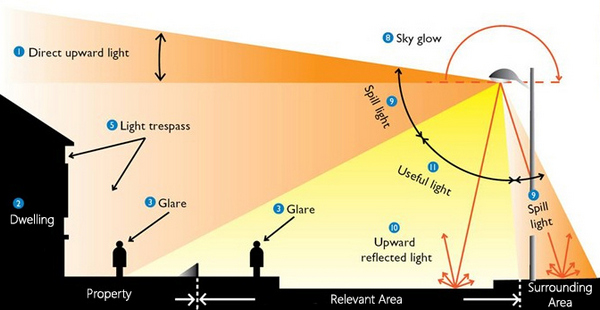Streetlights are being replaced from conventional technologies and converted into new LED solutions. This is not a new story but we are getting more and more information saying that the change to LED causes problems for people living nearby the newly installed LED streetlights. We at Lumia® would like to explain why this is not a problem for our streetlight solutions and how we are avoiding the issues faced by other streetlight brands.
Direction of Light
The direction of the light is important in several ways. Firstly, the light has to be directed towards the area designated to be illuminated and must avoid areas it is not intended to brighten up.
As illustrated below, the useful light will target this area and an onwards position from the streetlight pole until reaching the other side of the road, and go no further than the edge of the pavement. This is the basic function of the designated area that a streetlight should illuminate.
The streetlight in the example picture is problematic because it also reaches areas which it is not intended to. These areas are defined as spill light and any light in these areas is not functional. In some cases, they can even be a nuisance for the surroundings, for instance, by bothering house tenants whose houses get included in the spill light area.
 |
|
A diagram of factors that need to be taken into consideration for LED streetlight installations. (All photos and diagrams courtesy of Lumia) |
At the same time, this issue will also require a higher wattage of the streetlight since it would lose lux levels in the actual required areas.
The following project is an example that shows the difference between an incorrect installation (conventional solution) and a correct installation (optimized LED solution).
 |
|
Comparison of conventional streetlights and LED solutions. |
The Glare
Another parameter that needs to be considered is the glare that a streetlight can produce. Glare has a strong effect on the normal visual function, causing a serious threat to safety. The accumulative effect of glare also threatens the physiological health of the human body, caused by what is defined as blue light. These issues impact the eye due to the toxic effect of blue light, the risk of glare erupting from bad designs and the poor choice of components in the streetlight.
Blue light causes a photochemical risk to the eye: the level depends on the accumulated dose of blue light to which the person has been exposed, which is generally the result of low-intensity exposure repeated over long periods. Three groups are particularly at risk: children, population that is already light sensitive, and workers likely to be exposed to high-intensity lighting.
The other main risk from glare, for indoor lighting, is the fact that luminance higher than 10,000 cd/m² causes visual discomfort whatever the position of the lighting unit in the field of vision. Because the emission surfaces of LEDs are highly concentrated point sources, the luminance of each individual source can be 1000 times higher than that level. The level of direct radiation from this type of source can therefore easily exceed the level of visual discomfort.
Manufacturers and integrators of lighting systems using LEDs are encouraged to use optics or diffusers, for example, so that the beams of light emitted by the LEDs cannot be seen directly, to avoid glare. Manufacturers should also take into account the progressive wear of layers of phosphor in white LEDs, which in time could lead to devices being moved from one photo biological risk group to a higher one, according to ANSES.
We at Lumia® are proud to say that our streetlight solutions give not only directional illumination in the category of useful light, but furthermore they are designed with chips that are proven to be without any danger of blue light. We choose Luxeon T Chips, which are tested with IEC 62471:2006 and are causing no problems for photo biological safety issues.
Surge Protection
A reliable way to protect streetlight from excessive surge voltages is to use a Surge Protection. It is necessary to protect against lighting strikes or other overflows of electric currents.
The function of the Surge Protection is to limit the differential and common mode surge voltage inside the luminaire by offering a path with a lower break down voltage. The energy of the voltage surge is returned as a surge current, via the component to the ground and eventually returning to the cloud.
We at Lumia® offer a Surge Protection in our streetlight, which is capable of handling multiple strikes with a nominal current up to 5kV. It is even designed to handle a single strike between 5 to 10kV, though such large surges are unlikely in most places.
Wind protection
Lastly, we have also designed our streetlight in a way that not only are beautiful in design but also are fully functional in its operation. They need to endure strong weather conditions and be resistant to changes of all four seasons of the year.
We therefore ensure that our streetlight not only are protected in case of a thunder storm but also in the wind speeds in such an event. They are protected with up to Force 12 on the wind index.
We encourage you to have a look at our website for more information about our different Street Light Series and you are also more than welcome to contact us for further information.
Lumia® – A Registered Trademark of Monda Holding Aps.
www.lumiaonline.com













